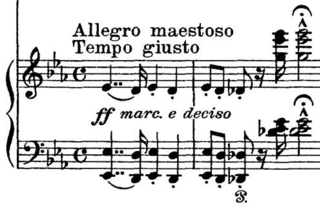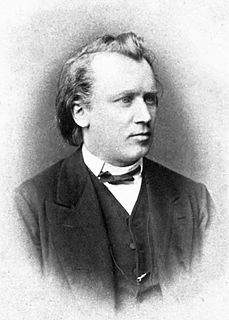
Claudio Arrau León was a Chilean pianist known for his interpretations of a vast repertoire spanning the baroque to 20th-century composers, especially Bach, Beethoven, Schubert, Chopin, Schumann, Liszt and Brahms. He is widely considered one of the greatest pianists of the twentieth century.
The Piano Sonata No. 10, Op. 70, was written by Alexander Scriabin in 1913. It was his final work in this form. The piece is highly chromatic and atonal like Scriabin's other late works, although arguably less dissonant than most of his late works. It is characterized by frequent trills and tremolos. It is sometimes called his "Insect Sonata", referring to his words:
Bagatelle sans tonalité is a piece for solo piano written by Franz Liszt in 1885. The manuscript bears the title "Fourth Mephisto Waltz" and may have been intended to replace the piece now known as the Fourth Mephisto Waltz when it appeared Liszt would not be able to finish it; the phrase Bagatelle ohne Tonart actually appears as a sub-title on the front-page of the manuscript.

Étude Op. 10, No. 12 in C minor, known as the "Revolutionary Étude" or the "Étude on the Bombardment of Warsaw", is a solo piano work by Frédéric Chopin written circa 1831, and the last in his first set, Etudes, Op. 10, dedicated "à son ami Franz Liszt".

Franz Schubert's Impromptus are a series of eight pieces for solo piano composed in 1827. They were published in two sets of four impromptus each: the first two pieces in the first set were published in the composer's lifetime as Op. 90; the second set was published posthumously as Op. 142 in 1839. The third and fourth pieces in the first set were published in 1857. The two sets are now catalogued as D. 899 and D. 935 respectively. They are considered to be among the most important examples of this popular early 19th-century genre.
Three Concert Études, S.144, are a set of three piano études by Franz Liszt, composed between 1845–49 and published in Paris as Trois caprices poétiques with the three individual titles as they are known today.
A Faust Symphony in three character pictures, S.108, or simply the "Faust Symphony", is a choral symphony written by Hungarian composer Franz Liszt inspired by Johann Wolfgang von Goethe's drama, Faust. The symphony was premiered in Weimar on 5 September 1857, for the inauguration of the Goethe–Schiller Monument there.

Franz Liszt composed his Piano Concerto No. 1 in E♭ major, S.124 over a 26-year period; the main themes date from 1830, while the final version is dated 1849. The concerto consists of four movements and lasts approximately 20 minutes. It premiered in Weimar on February 17, 1855, with Liszt at the piano and Hector Berlioz conducting.
A Symphony to Dante's Divine Comedy, S.109, or simply the "Dante Symphony", is a choral symphony composed by Franz Liszt. Written in the high romantic style, it is based on Dante Alighieri's journey through Hell and Purgatory, as depicted in The Divine Comedy. It was premiered in Dresden in November 1857, with Liszt conducting himself, and was unofficially dedicated to the composer's friend and future son-in-law Richard Wagner. The entire symphony takes approximately 50 minutes to perform. It premiered on 7 November 1857.

Funérailles is the 7th and one of the most famous pieces in Harmonies poétiques et religieuses, a collection of piano pieces by Franz Liszt. It was an elegy written in October 1849 in response to the crushing of the Hungarian Revolution of 1848 by the Habsburgs.
Frédéric Chopin's Piano Sonata No. 3 in B minor, Op. 58, is the last of the composer's piano sonatas. Completed in 1844 and dedicated to Countess Émilie de Perthuis, the work is considered to be one of Chopin's most difficult compositions, both technically and musically.
The Ballade No. 3 in A♭ major, Op. 47 is a ballade for solo piano by Frédéric Chopin, completed in 1841. A typical performance lasts seven to eight minutes.

Transcendental Étude No. 11 in D♭, "Harmonies du soir" is the eleventh étude of the set of twelve Transcendental Études by Franz Liszt. This étude is a study in harmonies, broken chords played in quick succession, full octave jumps, chromatic harmonies, chord variations, interlocking hands, bravura, massive chords, especially proper pedaling, and performance as a whole.
Alexander Scriabin's Fantasie in B minor, Op. 28, was written in 1900. This is a single sonata form movement which bridges the gap between Scriabin's third and his fourth sonata. Scriabin wrote this piece during an otherwise compositionally unproductive period during his tenure at the Moscow Conservatory. The first edition was published by Belaieff.
Ballade in the Form of Variations on a Norwegian Folk Song in G minor, Op. 24, is a large-scale work for piano by Edvard Grieg. It is in the form of theme and variations, the theme being the Norwegian folk song Mountain Song. A performance usually lasts around 20 minutes.
Hungarian Rhapsody No. 6 in D-flat major is the sixth work of the 19 Hungarian Rhapsodies composed by Franz Liszt. This work was dedicated to Count Antoine of Appony and uses the form of lassan and friska like many other of his rhapsodies. This piece was later arranged for orchestra.
Trois morceaux dans le genre pathétique Op. 15 is a three-movement suite for piano composed by the French composer, Charles-Valentin Alkan, published in 1837. The suite also bears the title Souvenirs (Memories). The 3 movements are Aime-moi, Le vent, and Morte.

The Piano Quartet No. 3 in C minor, Op. 60, completed by Johannes Brahms in 1875, is scored for piano, violin, viola and cello. It is sometimes called the Werther Quartet after Goethe's The Sorrows of Young Werther.

Mazurkas, Op. 59 are a set of three Mazurkas for solo piano by Frédéric Chopin. The set was composed and published in 1845.

Héroïde funèbre, S. 102, is a symphonic poem written by Franz Liszt in 1850 and published in 1857 as No. 8. The work originated as the first movement of a planned Revolutionary Symphony inspired by the July Revolution. Liszt pays homage in this programmatic symphonic poem to the soldiers and men that died fighting in revolutionary efforts. The composition of this piece was started in 1830 as a brief sketch for a full symphony, but was dropped by Liszt in the continuing of other works. However, in 1848, there was an uprising in Liszt's home country of Hungary. One of Liszt's friends was killed during this revolution, which caused Liszt to revisit his now 20 year old sketch of the Revolutionary Symphony, shortening it and forming the first movement into the commemorative Héroïde funèbre. Liszt said of the program, "In these successive wars and carnages, sinister sports, whatever be the colours of the flags which rise proudly and boldly against each other, on both sides they float soaked with heroic blood and inexhaustible tears. It is for Art to throw her ennobling veil over the tomb of the brave, to encircle with her golden halo the dead and dying, that they may be the envy of the living."








